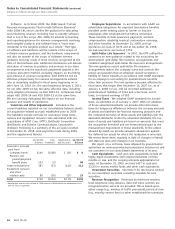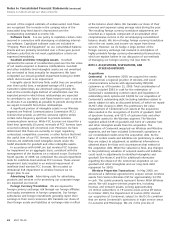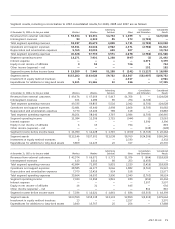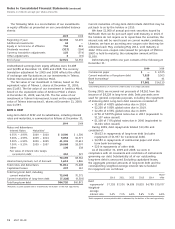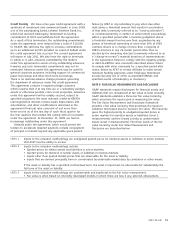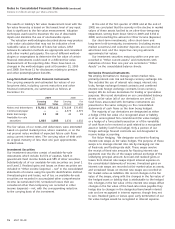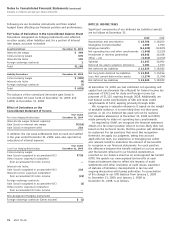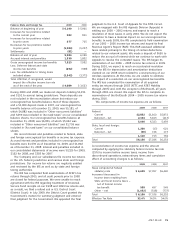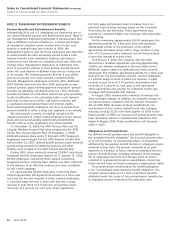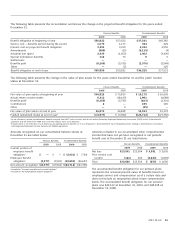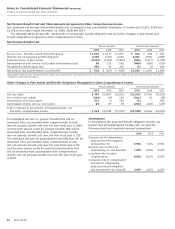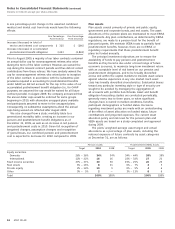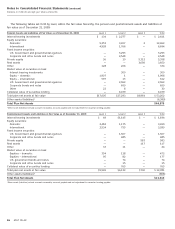AT&T Wireless 2009 Annual Report Download - page 78
Download and view the complete annual report
Please find page 78 of the 2009 AT&T Wireless annual report below. You can navigate through the pages in the report by either clicking on the pages listed below, or by using the keyword search tool below to find specific information within the annual report.
Notes to Consolidated Financial Statements (continued)
Dollars in millions except per share amounts
76 AT&T 09 AR
At the end of the first quarter of 2009 and at the end of
2008, we concluded that the severity in the decline in market
values of these assets had led to an other-than-temporary
impairment, writing them down $102 in 2009 and $332 in
2008, and recording the amount in Other Income (Expense).
Our short-term investments, other short-term and
long-term held-to-maturity investments (including money
market securities) and customer deposits are recorded at
amortized cost, and the respective carrying amounts
approximate fair values.
Our investment securities maturing within one year are
recorded in “Other current assets,” and instruments with
maturities of more than one year are recorded in “Other
Assets” on the consolidated balance sheets.
Derivative Financial Instruments
We employ derivatives to manage certain market risks,
primarily interest rate risk and foreign currency exchange risk.
This includes the use of interest rate swaps, interest rate
locks, foreign exchange forward contracts and combined
interest rate foreign exchange contracts (cross-currency
swaps). We do not use derivatives for trading or speculative
purposes. We record derivatives on our consolidated balance
sheets at fair value (all of our derivatives are Level 2).
Cash flows associated with derivative instruments are
presented in the same category on the consolidated
statements of cash flows as the item being hedged.
The majority of our derivatives are designated as either
a hedge of the fair value of a recognized asset or liability
or of an unrecognized firm commitment (fair value hedge),
or a hedge of a forecasted transaction or of the variability
of cash flows to be received or paid related to a recognized
asset or liability (cash flow hedge). Only a portion of our
foreign exchange forward contracts are not designated to
receive hedge accounting.
Fair Value Hedging We designate our fixed-to-floating
interest rate swaps as fair value hedges. The purpose of these
swaps is to manage interest rate risk by managing our mix
of fixed-rate and floating-rate debt. These swaps involve
the receipt of fixed rate amounts for floating interest rate
payments over the life of the swaps without exchange of the
underlying principal amount. Accrued and realized gains or
losses from interest rate swaps impact interest expense on
the consolidated statements of income. Unrealized gains on
interest rate swaps are recorded at fair market value as assets,
and unrealized losses on interest rate swaps are recorded at
fair market value as liabilities. We record changes in the fair
value of the swaps, along with the changes in the fair value of
the hedged asset or liability that is attributable to the hedged
risk. Changes in the fair value of the interest rate swaps offset
changes in the fair value of the fixed-rate notes payable they
hedge due to changes in the designated benchmark interest
rate and are recognized in interest expense, though they net
to zero. Realized gains or losses upon early termination of our
fair value hedges would be recognized in interest expense.
The asset’s or liability’s fair value measurement level with the
fair value hierarchy is based on the lowest level of any input
that is significant to the fair value measurement. Valuation
techniques used need to maximize the use of observable
inputs and minimize the use of unobservable inputs.
The valuation methodologies described above may produce
a fair value calculation that may not be indicative of net
realizable value or reflective of future fair values. AT&T
believes its valuation methods are appropriate and consistent
with other market participants. The use of different method-
ologies or assumptions to determine the fair value of certain
financial instruments could result in a different fair value
measurement at the reporting date. There have been no
changes in the methodologies used at December 31, 2009
and 2008. See Note 11 for disclosures relating to pension
and other postemployment benefits.
Long-Term Debt and Other Financial Instruments
The carrying amounts and estimated fair values of our
long-term debt, including current maturities and other
financial instruments, are summarized as follows at
December 31:
2009 2008
Carrying Fair Carrying Fair
Amount Value Amount Value
Notes and debentures $71,811 $75,212 $70,208 $70,955
Commercial paper — — 4,575 4,575
Bank borrowings 33 33 41 41
Available-for-sale
securities 1,885 1,885 1,632 1,632
The fair values of our notes and debentures were estimated
based on quoted market prices, where available, or on the
net present value method of expected future cash flows
using current interest rates. The carrying value of debt with
an original maturity of less than one year approximates
market value.
Investment Securities
Our investment securities consist of available-for-sale
instruments which include $1,574 of equities, $226 in
government fixed income bonds and $85 of other securities.
Substantially all of our available-for-sale securities are Level 1
and Level 2. Realized gains and losses on these securities are
included in “Other income (expense) – net” in the consolidated
statements of income using the specific identification method.
Unrealized gains and losses, net of tax, on available-for-sale
securities are recorded in accumulated other comprehensive
income (accumulated OCI). Unrealized losses that are
considered other than temporary are recorded in other
income (expense) – net, with the corresponding reduction
to the carrying basis of the investment.


